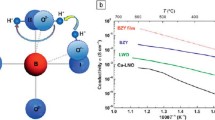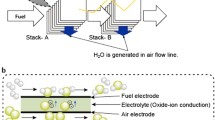Abstract
Solid oxide fuel cells (SOFC) are promising devices for high efficiency cogeneration. The most widely used and studied ones have an anion conducting electrolyte that requires high operating temperatures to limit ohmic losses across this electrolyte; temperatures typically range between 800 and 1,000 °C. This temperature is associated with undesirable phenomena such as material interaction and insulating phase formation that result in unsatisfactory durability and high cost for market entry. Proton conducting solid oxide fuel cells (PCFC) constitutes a promising alternative since they allow a significant decrease in operating temperature. The Ba(Zr,Ce,Ln)O3−δ perovskite family exhibits ionic conductivities reaching 10−2 to 10−1 S cm−1 at temperatures as low as 600–700 °C, these values being obtained with anion conducting SOFC between 700 and 1,000 °C. On the basis of a review of work on half cells and complete cells, this paper addresses the main parameters that control and limit PCFC behaviour. This analysis aims at proposing recommendations for designing and testing proton conducting fuel cells.










Similar content being viewed by others
References
Eguchi K, Singhal SC, Yokokawa H, Mizusaki J (2007) Proceedings of SOFC X, Electrochemical Society, ECS transaction, 7:1
European fuel cell and hydrogen projects 2002–2006, (2007) EUR 22398, IBSN: 92-79-02692-5 http://ec.europa.eu/research/energy/
Solid state energy conversion alliance (SECA) program. http://www.netl.doe.gov/technologies/coalpower/fuelcells/seca/
Nopponen M (2006) J Fuel Cell Sci Technol 3:438
Private communication Nabielek H, Steinberger (2006) REAL SOFC Summer school 2006. http://www.real-sofc.org/
Menzler NH, de Hart LGJB, Sebold D (2007) ECS Transact 7:245
Iwahara H (1996) Solid State Ionics 9:86
Kreuer KD (2003) Annu Rev Mater Res 33:333
Iwahara H (1995) Solid State Ionics 77:289
Dah PI, Haugsru R, Lein HL, Grande T, Norby T, Einarsrud MA (2007) J Eur Ceram Soc 27:4461
Balachandran U, Lee TH, Dorris SE (2007) ECS Transact 7:987
Ranran P, Yan W, Lizhai Y, Zongqiang M (2006) Solid State Ionics 177:389
Kek D, Bonanos N, Mogensen M, Pejovnik S (2000) Solid State Ionics 131:249
Akimune Y, Matsuo K, Higashiyama H, Honda K, Yamanaka M, Uchiyama M, Hatano M (2007) Solid State Ionics 178:575
Mather GC, Figueiredo FM, Fagg DP, Norby T, Jurado JR, Frade JR (2003) Solid State Ionics 158:333
Tolchard JR, Grande T (2007) Solid State Ionics 178:593
Tolchard JR, Grande T (2007) Solid State Ionics 180:2808
Iwahara H, Asakura Y, Katahira K, Tanaka M (2004) Solid State Ionics 168:299
Coors WG (2004) J ElectroChem Soc 151:7 A994
Description of the GEMINI code: Gibbs Energy Minimizer. http://thermodata.online.fr
Author information
Authors and Affiliations
Corresponding author
Rights and permissions
About this article
Cite this article
Lefebvre-Joud, F., Gauthier, G. & Mougin, J. Current status of proton-conducting solid oxide fuel cells development. J Appl Electrochem 39, 535–543 (2009). https://doi.org/10.1007/s10800-008-9744-7
Received:
Revised:
Accepted:
Published:
Issue Date:
DOI: https://doi.org/10.1007/s10800-008-9744-7




